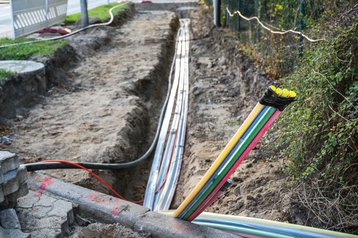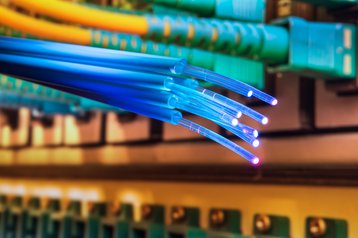Data centers are a labyrinth of individual parts, working together to create an infrastructure that links to other infrastructures, to make up what we know today as the Internet. The problem with this is that individual parts fail, and when they do, the impact on your data center’s performance can be huge.
Luckily, there’s Exfo, a company that specializes in equipment to test, analyze, and diagnose data center components so you can repair or replace them with the minimum of fuss. DCD caught up with Exfo’s data center solution manager, Nicholas Cole, to discuss the importance of testing data center components and how the AI revolution relies on optical fiber and high-speed data transfer.
Nicholas starts by outlining the problem: “When it comes to the big companies, the big cloud operators, and the big social media companies – everything at the moment is about AI, and about how we now re-architect the network, the internal data centers and how we reconfigure them to run these AI workloads.”
Cole explains that the arrival of AI has shone a light on the issue of density, as the amount of data flowing across interconnects and the power they draw increases exponentially.
“For us, it's all about figuring out what those networks are now going to look like,” he tells us. “We know they're going to be much denser, with more transceivers and optical connections, meaning reconfiguration of the data halls to support clusters that make the network act as a single processing unit – a single brain.”
This, he notes, “is raising the importance of networking because it’s vital to take away all the bottlenecks to maximize bandwidth and reduce latency.”
No data center is an island, and one of Cole’s key messages is the importance of ensuring that your facility can connect effortlessly to the outside world. “The increased workload isn’t [just] happening inside the data center - there's going to be more coming in and out, so some facilities may struggle from a lack of wide area network (WAN) connectivity.”
The same applies to Edge facilities, where there “will be space and power challenges inside as we try and scale up this high-density infrastructure.”
Whatever happened to IoT?
But, we point out, much of the promise of technologies such as AI and the Internet of Things (IoT) have failed to materialize, so far. Cole counters that the revolution has been delayed, not canceled, and we all need to stay prepared.
“The rollout of AI should fuel new applications connecting IoT devices, which up until now have not matched forecasts – maybe because of Covid – and that has slowed things down inside buildings, but as we see more smart cities and smart buildings, that's when you're going to see more data passing from smart buildings back to data centers, and that's where the traffic flowing out to the Edge and back to the core is going to then start to increase.”
Latency: The new enemy
When this seachange finally manifests, your interconnections will be everything – because, as Cole reminds us, they could be the difference between life and death to an end user: “Latency is the new enemy before it was all about bandwidth. Now it's bandwidth AND latency, because of the bidirectional communication you need between two devices. It's crucial for AI that latency is very low. There are distance limitations – because light travels across the glass at a certain speed. The longer that glass and fiber, the slower it is, and therefore the latency is going to be increased.
“Outside the data center, if we talk about remote vehicles and remote surgery and all those futuristic applications, latency is key because things are happening in real-time.”
It’s that crucial reliance on low latency that has brought the need for strong, robust networks into sharp focus, and that’s where Exfo comes in: “When you first install something, there's a chance that you didn’t install it properly and therefore it's going to impact the performance.
“Should there be any problems, we help walk the user through what they are. We make network test equipment for data center operators or contractors so, for us, it's all about understanding what they're doing and then designing products that help them do their job better and that they can test things efficiently.”
No fear of failure
He goes on to warn of the potential pitfalls of a failure – especially when uptime and network performance are mission critical. “All of a sudden, you've got traffic going on a single highway or less, there are fewer paths to take the traffic, and therefore it impacts your performance. If something's failed, you would need to go and find out exactly what. It can either be passive, which is the cabling, or it can be active, which are the transceivers and the switches or the servers.”
If something does go down, technicians go in and “help localize which component has failed. That's what our equipment does.”
Ironically, it’s the process of upgrading that often causes exactly the types of faults that require Exfo testing equipment.
That can be because of an actual malfunction: “Fiber lasts forever, it doesn't degrade. It lasts for decades, maybe even centuries, so provided you don't touch that cable, then it should be fine. However, the reality is people do touch things because there are technicians inside these data centers constantly upgrading and fixing things. It's human hands that create issues.”
Or, increasingly, because the loads being carried by your data center have outgrown the cabling: “The technology will require certain performance that cable may not be able to support.”
Hollow: Is it this you're looking for?
As you increase data rates in and between data centers different modulation technologies are used to transmit the signal, which requires specific performance levels from the network link... “New fiber types, optical elements, and additional capacity may be needed to support new high-speed systems.
The solution is, at least in part, a newer kind of optical medium “A new trend is hollow core fiber where there is no glass in the core of the fiber, just a void, which can mean better speed because the light doesn't have to pass through the glass, drastically reducing latency. It has a big advantage in the speed of light that can travel through the cable. When you're joining New York to Paris, if you can get an advantage on speed, your latency is reduced massively.“
Finally, we look to the future. The other side of the AI revolution is the opportunity for companies to integrate AI into their products. We ask Cole if that is something that Exfo is looking at. Whilst there is nothing imminent to announce, the company understands the possibilities that AI offers in both proactive and reactive testing: “AI in our equipment is something that we are investigating, particularly from the perspective of collecting test data - telemetry and analytics. We can learn from those test results, so we are thinking about what role AI could have in analyzing and automating, based on the learnings from the data.”
In the next part of our interview with Exfo, we look at the specific challenges of upgrading and maintaining a data center in this time of vast bandwidth increase, coupled with power limitations.


